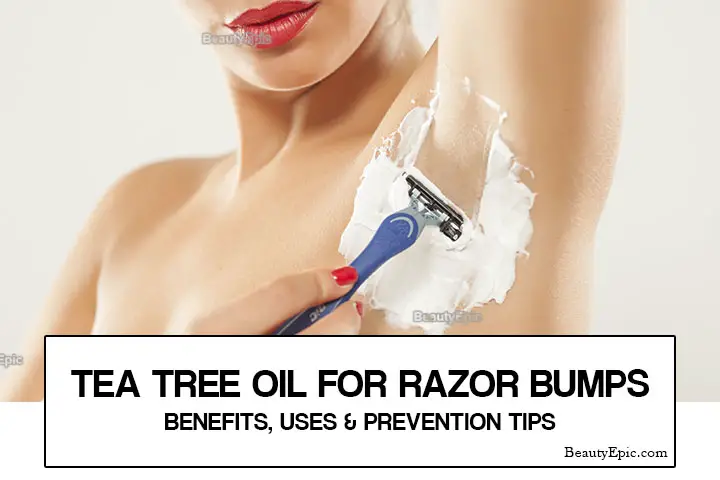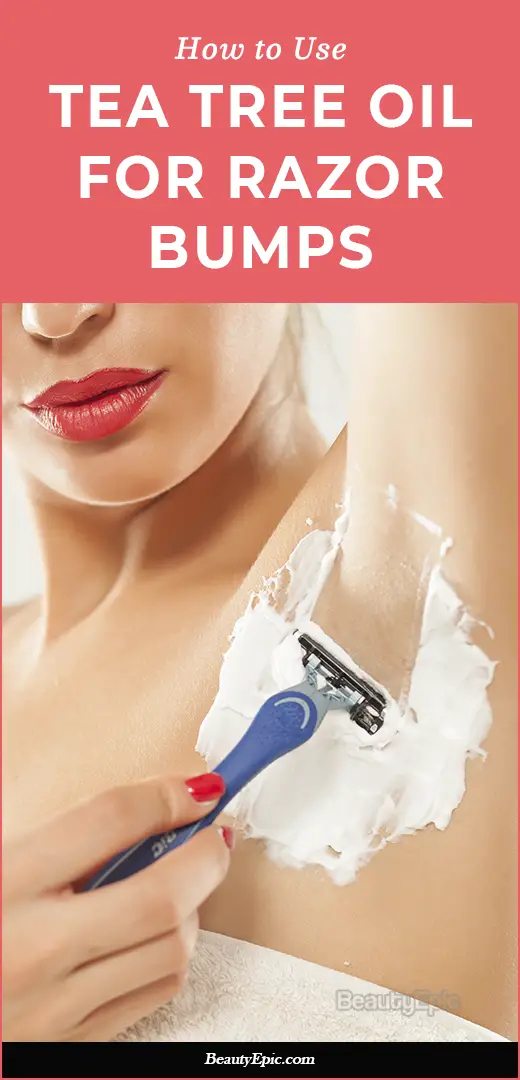
Important: This article is for informational purposes only. Please read our full disclaimer for more details.
When you shave, if the hair curls and starts to grow-on instead of out of the skin, then it is referred to as ingrown hair. This causes your skin to be bumpy which means you will develop razor bumps. It might appear like a dot or bump on the skin. At times, these are itchy and painful and at other times they are infected or inflamed. However, you can banish the discomfort at your own home using tea tree oil.
Does Tea Tree Oil Help with Razor Bumps?
Tea tree oil can treat razor bumps in three main ways. It can prevent, heal, and keep you from developing an infection. It is made of robust active components known as terpenes that serve as strong deterrents against microbes and bacteria. Due to these antibacterial properties, it can be pretty effective when it comes to treating razor bumps.
[ Read: How to Use Baking Soda for Razor Bumps ]
Coconut oil and Tea Tree oil for Razor Bumps
Things Required:
- Tea tree oil.
How to Do:
- It is a known fact that coconut oil is great for your skin. As a matter of fact, it can be effective for treating razor bumps due to its antiseptic and anti-inflammatory properties.
- In order to prepare the mix, you will have to take on a tablespoon of coconut oil and one tablespoon of tea tree oil. Stir it till it combines.
- Apply it on the affected area and leave it for 10-15 minutes. Wash it off using lukewarm water.
Best Time to Apply: Before bath.
No of Repetitions: Do this twice in a day.
[ Read: How to Use Aspirin for Razor Bumps ]
Aloe Vera and Tea Tree oil for Razor Bumps
Things Required:
- Tea tree oil.
How to Do:
- Aloe vera is known to heal and soothe burns. As per the studies, a thin layer of it can treat razor bumps.
- To prepare the recipe, you will need one tablespoon of aloe vera gel and one teaspoon of tea tree oil.
- Mix it in a bowl and apply it to the affected area. Leave it for 15-20 minutes. Wash it off with cool water.
Best Time to Apply: Before bath.
No of Repetitions: Repeat this process twice every day to get the best result.
3. Witch Hazel and Tea Tree Oil
Things Required:
- Tea tree oil.
How to Do:
- Witch hazel is a natural anti-inflammatory and astringent. This is because of the tanning content. It is used for the treatment of minor skin irritation.
- Take one teaspoon of witch hazel and one tablespoon of tea tree oil. Mix it well. Apply it on the razor bumps.
- Leave it for 15 minutes before washing it off with cool water. You can apply it any time of the day.
Best Time to Apply: Before bath.
No of Repetitions: Do this once every day to reduce your razor bumps.
Razor bumps can be pretty uncomfortable and unsightly. If you use an essential oil like tea tree oil, it will prevent and also treat ingrown hairs. It also acts as a natural moisturizer. Tea tree oil penetrates the surface of the skin and keeps it hydrated. However, if you have sensitive skin, you need to do a patch test before using any of the above remedies. The acidic content of the oil might give you a burning sensation but that it normal and there is nothing to worry.
You Might Also Like:
- What’s Causing This Bump on My Forehead, and Should I Be Concerned?
- Why Do I Have A Bump On My Nose?
- Bump on the Side Foot – Common Causes & Treatment Options
- How to Get Rid of a Nose Piercing Bump?
- Why Do I Have White Bumps on My Tongue?
- How to Tell If It’s Herpes or Razor Bumps? Causes, Symptoms and Treatment
- Apple Cider Vinegar for Razor Bumps – Benefits and Uses
- 7 Best Razors For Sensitive Skin
- How to Use Aspirin for Razor Bumps
- The 12 Best Home Remedies To Get Rid Of Razor Bumps Fast
- Embrace the Secrets of Silky-Smooth Skin
- Baking Soda for Razor Bumps – Benefits and Uses
- How to Get Rid of Razor Bumps In The Bikini Area
- How to Get Rid of Razor Bumps Using Aloe Vera?
















